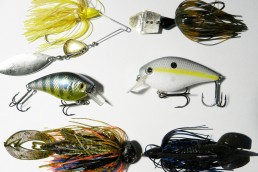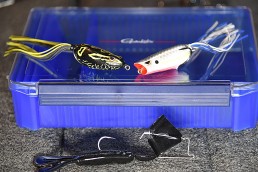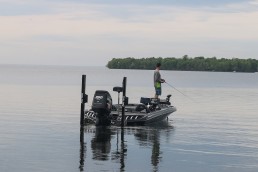Minnesota Opening-Day Bass Tactics
SHARE THIS POST
It has been a challenge for all of us the last few months, and not having a crystal ball to see into the future, I am hoping that the upcoming fishing season will help put us all get back on track and moving forward again. Looking ahead a little, we have had a pretty mild winter up here in Minnesota, as many of us did not have the best of ice fishing seasons due to lack of cold weather. So hopefully, the open-water season will help make up for some of that. This year, we are probably going to have open water in parts of the state in early April, and in many places, this is a good 2 to 3 weeks earlier than normal. If I remember right, the last time that happened was about 15 years ago. Let’s look at what the Minnesota Bass Opener should look like this year when it opens on May 23.
When we hit the waters this bass opener, assuming we continue down this path of above-normal temperatures, the bass will be close to being done spawning, or have just finished. What does that mean for us when we get on the water?
Many years, we are generally hitting the waters from central and southern Minnesota when the bass are just starting to spawn during the last week of May. But with the probability of the spawn being completed, we will have to deal with post-spawn bass conditions, and at times that bite can be tough.
With the groundwork laid to cover your bases, make sure that you take a quick trip through the shallows to look for signs of bass up along the shore, and look for beds at the same time. If things go as thought, you may still find some late spawners on the beds. By doing this, it will also give you a starting point to look for post-spawn bass.
You need to cover water to make your first contact, so grab either a spinnerbait or chatterbait and get to work. Move through these areas slowly; do not fly through them. The bass will be a little shut down, but in the same breath, they are looking for food again to build up their strength from the recent spawning ritual. So, the bite odds are in your favor. The more you can make your bait contact the cover that the bass are sitting in, the more bites you are going to get.
As you are searching, pay special attention to the cover that you are fishing. Look for cover changes like inside weedlines, cabbage weeds butted up to coontail weeds, and so on. These areas will attract bass looking for a good place to hide and ambush food.
Once you do get into an area where you start to contact fish, you will want to put your moving bait option down and grab a bait that you can pick the cover apart with. A Jig-n-Chunk or a Trickstick rigged either unweighted or weighted are all good choices. Once again, pick areas apart looking for key bites
Keep your jig offerings on the lighter side unless you are fishing in windy conditions: 1⁄4- and 3/8-ounce will get the call. Pay attention to the trailers that you are picking and using. Using a trailer that has some action to it will slow the fall of your jig down and keep it in the strike zone longer. If you are looking to add a little more action to your jig, you may want to turn toward a smaller swimbait tail or a bigger grub to give your jig added movement and attraction.
Are you enjoying this post?
You can be among the first to get the latest info on where to go, what to use and how to use it!
When it comes to Trickstick options, rig one or two unweighted and another weighted. For the weighted choice, rig with a 1/8-ounce tungsten slip sinker that is pegged. The reason for pegging the sinker is, you want the weight to stay with the bait as it falls through the weeds. This rigging will give you a better hook-up ratio, as the weight will not be separated from the bait.
When it comes to unweighted options, I always rig a few different ones. I will grab a spinning rod and rig a Trickstick wacky unweighted, and on another spinning setup I will rig a weightless Texas-rigged Trickstick. Both offerings will look more natural to the bass by having a slower fall than an option that is weighted.
Many times, these options generate most of the strikes from finicky bass looking for food when fished in non-windy conditions. If the conditions are windy, I will move to a weighted wacky option, but it is my goal to keep my weight minimal, enhancing as much of the natural action these baits have to trigger bites.
Another option to try is a tube. Make sure you keep them in the boat for the next two weeks and more if you want to get the most out of them. If I am fishing hard-bottom areas, I will use a jig head/tube combo with the jig head rigged on the outside of the tube. The exposed jig head transfers more feel than a jig head that is pushed inside of the tube. If I am fishing it in the weeds, I will rig the tube with the jig head inside of the tube.
Always pay attention to the eye angle of the jig that you are using. If the eye is 90 degrees to the hook, the tube will fall in a circle motion above the bass on a semi-slack line. If you use a 60-degree eye jig head, that will give your tube more of a gliding action as it falls on a semi-slack line.
Use this to your advantage if the bass are locked down in one place. Use a 90-degree jig, as the tube will stay closer to the bass that you are trying to trigger to bite. If you are searching around looking for bites, use the 60-degree jig option, as it will cover more water when falling.
One last tactic to talk about as the post-spawn is in full swing is to use a square-bill crankbait. These cranks trigger strikes when they contact the cover and break free. Bass cannot stand this action and will be all over these baits. Use this triggering action to your benefit. These baits will also get you fishing a new depth range as the bass continue to move deeper.
I hope these tips and tactics help you put a few more bass in your boat this Minnesota Bass Opener. Have a great bass season this year.
MWO
SHARE THIS POST
Did you enjoy this post?
You can be among the first to get the latest info on where to go, what to use and how to use it!
Scott Petersen
Scott Petersen has been writing for the past 30 years. A Minnesota native, he has a passion to fish all seasons on ice and open water. “One of my main goals is to teach people how to fish through my articles and sport-show seminars.”



